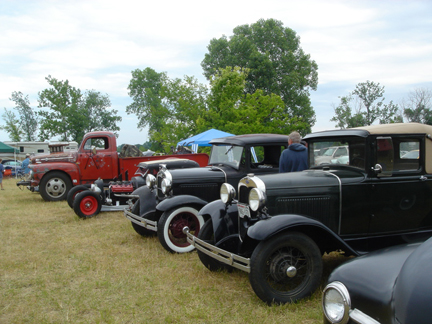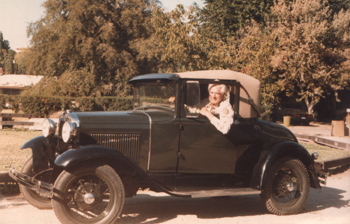Yesterday my pal Devin came over and we spent almost the whole day working on my family’s Model A. The basic plan was that he was going to come up from Bedford to show me how to work on the brakes, and help me check them out to see if they were in good shape. As it turned out, we didn’t even get to the brakes until something like 9 pm.
The first thing we did was to try to get the engine started. I had had it running, but I was having trouble with the battery. I’m fairly sure that the generator (the thing that charges the battery while you drive) is bad and needs a complete overhaul, AND it seems as though the battery charger I bought has died. So Devin brought his Dad’s charger up and we got my battery charging right away. Devin double-checked how I had the timing set and made a little adjustment, and we got the engine running. A lot of time was spent fiddling, making small adjustments, and trying to see where to set all the knobs and levers in the passenger compartment, and on the carburetor. We stopped the engine every so often to do this or that, and it wouldn’t always start back up again. Twice the car wouldn’t start because it had run out of gas, but sometimes we just couldn’t figure it out.
Fortunately Devin has more experience than I do with cars in general, but especially with Model A’s. He showed me a wiring diagram in the The Model A Ford Mechanics Handbook Volume 1, by Les Andrews, got out his test light and we followed it until we found a bad connection on the ammeter inside the dash. It was a quick fix.
Then we noticed that the coil (essentially a big capacitor that ramps up the 6V from the battery into 20,000V for the sparkplugs) was getting really hot. It normally gets warm, but this was hot enough that it was hard to touch.
Devin said, “You know, we can just go down to AutoZone and get a new one. They’re only like fifteen bucks. We just have to convince them that they actually have it so they will sell it to us.â€
Devin, Vader, and I piled in the Prius (the pinnacle of modern automotive technology) to go off to buy a part for the second model car that Ford ever made (the pinnacle of automotive technology in 1930). It was a nice contrast.
We walked into AutoZone, and there was an older guy and a young guy working. I always go to the older guy if I have the choice, but he was busy.
“Hi. We’re looking for a 6V coil.†I said.
“What the hell are you talking about?†The young guy said.
I started laughing. This was typical AutoZone, and exactly what we both expected. “It’s for a 1930 Model A Ford.â€
“Oh. You need to talk to that guy,†he said pointing to the older guy, “he knows about old cars and stuff.â€
We went over to chat with the older guy, and he helped us work it out.
“A coil? Could it be called an ignition coil?†he asked.
“Sure. That would make sense.†Devin and I said together.
He punched in “6V ignition coil†under the category for 1930 Model A Ford (which I was surprised was even in their computer), and out popped the shelf number. He went to get it, and when he came back he made a funny production out of blowing the dust off the box. $14 later we were back in the car on the way home.
(more…)



